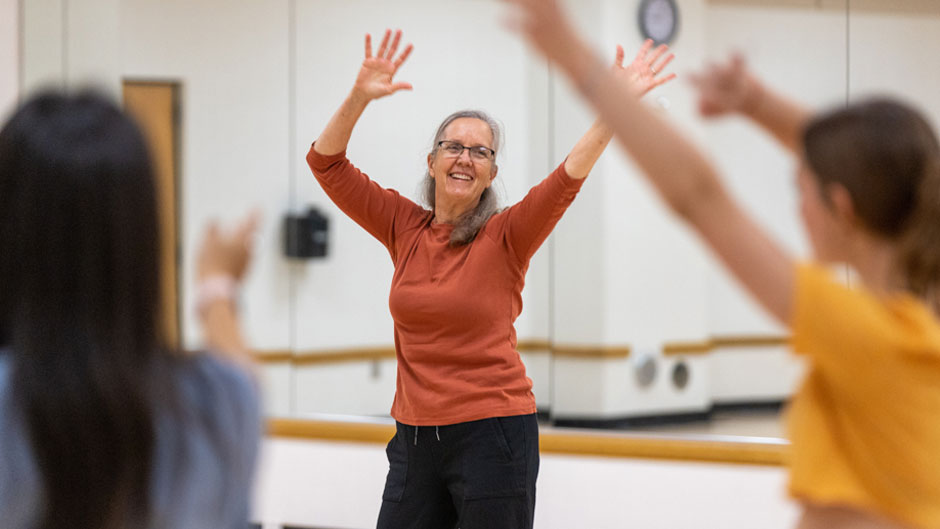On the second floor of the University of Miami Patti and Allan Herbert Wellness Center, a small class of undergraduate students sitting in a circle eagerly awaited their professor’s next instruction.
The students were coached to make push and pull motions with their hands—back and forth, back and forth—as if to create a gesture that signifies “clearing some space for yourself.” With each movement, the students were learning to manage their life stressors and mobilizing their brains to think positively.
The activity was a dance therapy exercise that Carol Kaminsky, senior lecturer in dance, teaches in Introduction to Dance Therapy. The course is available as part of Creative Arts in Therapy: Integrating Music and Dance into Counseling and Healthcare, a cognate that explores how creative arts are incorporated as treatment in mental health, rehabilitation, and other medical settings.
The Creative Arts in Therapy Cognate allows students to choose courses from three categories: Dance and Music Therapy, Understanding Dance and Music, and Counseling and Psychology. To complete a cognate, students must earn a minimum of nine credits in at least three courses. Creative Arts in Therapy satisfies the Arts and Humanities cognate requirement for undergraduate students.
Sarah Sluka, a sophomore from Titusville, Florida, in the School of Nursing and Health Studies, enrolled in Kaminsky’s Dance Movement Therapy course because she is intrigued by the field of creative arts as a form of both mental health and physical therapy. She said the course has given her a newfound appreciation for dance as more than an art form but as a healing form as well.
“This class lets me test out the waters of both fields [mental health and physical therapy] and what they might look like while still pursuing my nursing degree,” said Sluka. “In this course, I’m learning the importance our physical bodies have on our emotional health. Something as simple as posture can change the way we are feeling.”
Over the years, students have enrolled in the courses within the cognate to learn how art-based expression, communication, and engagement is essential and therapeutic for people coping with various psychological, physical, and developmental losses. Since the start of the pandemic, Kaminsky said, more students have been enrolling in the courses, creating a waitlist for open seats to appear. She said this is “the best problem to have.”
“We are planning to add another professor in the fall to serve as many students as possible without increasing class sizes,” said Kaminsky, a board-certified dance-movement therapist and nationally certified counselor with more than 30 years of experience. “When everyone wants to be in your class, it’s a great feeling, and because I have such a generous heart, I don’t want to turn any students away.”
The students praise Kaminsky for her ability to read the room and be adaptable with her lesson plans. Sluka said that her most memorable moment in the class was when Kaminsky could sense the whole group was weary, and she quickly changed course to help the students overcome their tiredness.
Ishaan Chatterjee, a senior majoring in microbiology from Bedford, New Hampshire, hopes to become a physician one day. He said Kaminsky’s expertise has created a comfortable environment, which creates a space for students—no matter their dance background—to be the best versions of themselves.
“A lot of times as pre-health students we take a lot of science-based classes, but introduction to dance therapy offered a new way to cultivate a new interest outside of the standard classroom,” said Chatterjee.
Students in the course study improvisation to elicit their own inner imagery with some suggestion from Kaminsky. This provides a space for them to open their minds to address, release, and manage stress—a tool that can be beneficial for future nurses and doctors to help them understand and counsel patients.
Kaminsky has found that students appreciate sharing their feelings in a small group. Each semester, on the first day of class, students agree to confidentiality—nothing discussed in the class is talked about with anyone outside of class. They can talk about their own experience, but they aren’t allowed to talk about other students in the class.
“Sharing is not easy,” said Kaminsky. “College students these days are more shielded. My personal feeling is that social media has made people more guarded and socially anxious.”
Future music therapist Rachel Hornback, a first-year Frost School of Music student from Orlando, looks forward to working with patients in rehabilitation to use the skills and knowledge she’s acquired in her dance and music therapy courses.
“There are such little things that you can do that have such a huge impact on your mind and body,” said Hornback.
“My hope,” Kaminsky added, “is that students can use what they have learned in this class in their everyday life and apply it to their future careers.”
Learn more about the cognates program at https://cognates.miami.edu/

